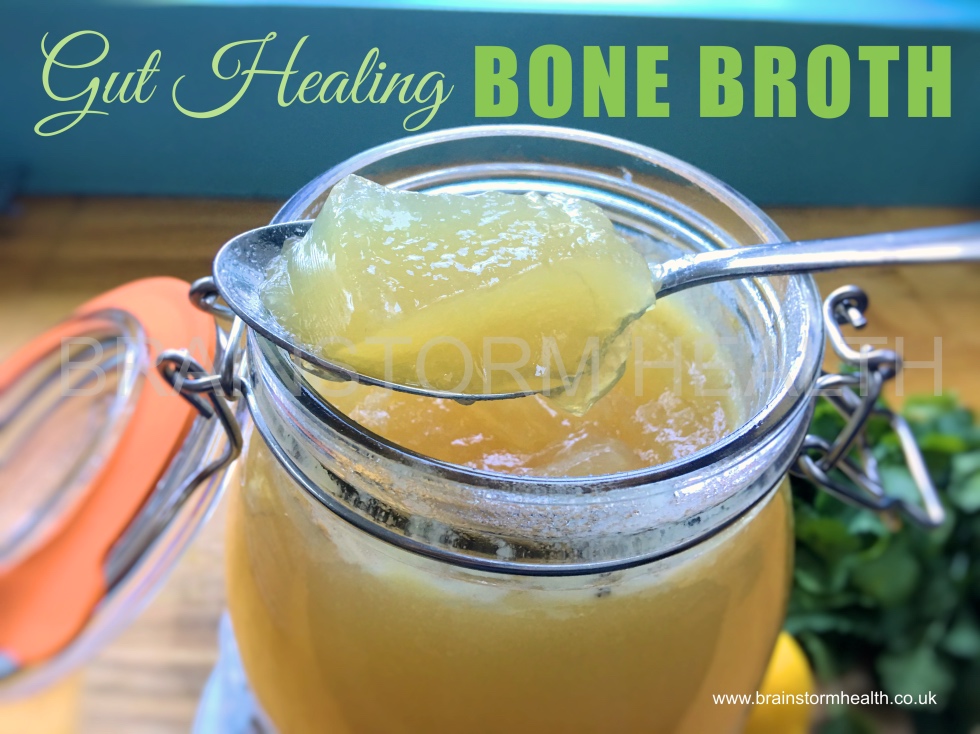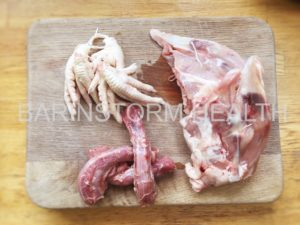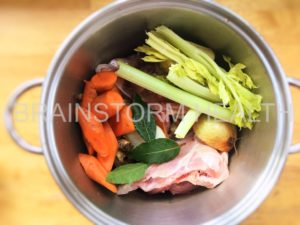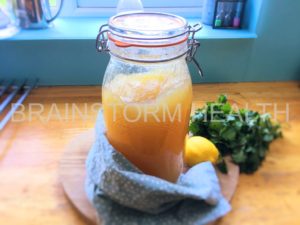ORGANIC GUT HEALING BONE BROTH
You need to get a few basics right to make delicious, gelatinous, gut-healing bone broth. This recipe will reward you with the most exquisite and nutritious broth you will ever taste.
Bone broths are the cornerstone of a gut healing protocol, and it could not be easier to incorporate into the daily diet. You can take it straight or in soups, poach meat and fish, cook beans, cook rice and other grains, use it in dressings and in some cases, we have even managed to sneak it in a smoothie for the trickiest of a customer!
It is essential that the bones are sourced from an organic and ethical supplier. We have used chicken bones in this recipe as this is the mildest broth and appeals to the majority. You can also use beef or pork bones – I am not a fan of lamb bones as the taste is too strong, but some people love that. You can also use wild meat and bird bones – as long as you have a great source, most bones would work well.
To get our chicken broth truly gelatinous, we have used the chicken carcass as well as the necks and the feet – the feet are essential – I know that there might be a yuk factor for some, but without the chicken feet, the broth will be watery and not nearly as healing. We buy our bones from Green Pasture Farms or Primal Meats – both are excellent suppliers, and we love their ethical stance and great service.
We use vegetables in the broth to add both flavour and goodness- especially improving the mineral content of the broth. We have used Kombu in this recipe both for the depth of flavour (albeit very mild) and for the extra minerals, especially iodine, which is significant in thyroid health and for cognition and tends to be low in most people.
IMPORTANT NOTE: Long-cooked bone broth contains high histamine and free glutamate levels. Some kids/adults may find this unhelpful and cannot tolerate it well. In cases where bone broth doesn’t seem to agree, I recommend making a meat broth with a whole chicken or joint of meat (bone-in). Place the meat in a large pan and cover it with water – you can also add all the other vegetables. Bring to a boil and then simmer for 2 to 3 hours. Strain the liquid and use this as a starting point for your gut healing protocol. You may then, at some point, be able to migrate up to the using bone broths.

Ingredients
- 2 raw chicken carcass
- 6 raw chicken necks
- 10 raw chicken feet
- 2 large carrots - chopped
- 3 sticks celery - chopped
- 2 large onions - chopped
- 3 whole bay leafs
- 10 whole peppercorns
- 4 litres filtered water
- 1/4 cup apple cider vinegar
- 1 Stick dried kombu
Instructions
- Place all the ingredients in a large stock pan, bring to the boil and let simmer for between 12 and 24 hours on low heat. The longer you simmer the more intense the broth will be. The one in the picture was kept simmering for 12 hours. Also of note is that the longer you simmer the broth the less the final quantity will be in terms of volume.
- Strain and place the liquid in glass jars and store in the fridge. It will keep in the fridge for at least 5 days or you can freeze the broth for up to 3 months.
- Once the broth has cooled you will get a layer of fat settle on the top. You can gently remove this and use it in cooking instead of other oils. It's especially good for roasting vegetables.
Notes
THE SCIENCE BIT
Bones contain 20 different amino acids, much of which end up in bone broth – the levels will vary depending on the cooking length and the bones’ quality. Bone broth also contains GELATIN and COLLAGEN, which play important roles in tissue development and regulation. GLYCOSAMINOGLYCANS (GAGs) are also found in bone broth. They are complex carbohydrates which can attach to proteins to form proteoglycans, integral parts of connective tissue and synovial fluid, the lubricant surrounding the joint. GLYCINE is another superstar in bone broth. It is a key amino acid mediating inhibitory neurotransmission in the brainstem and spinal cord. PROLINE is another amino acid found in abundance in bone broth and makes up about 20% of collagen, and binds to glutamate and glycine receptors. Many have heard of the gut-healing amino acid GLUTAMINE, which can directly cross the blood–brain barrier and has been shown to support and heal intestinal epithelial cells.





